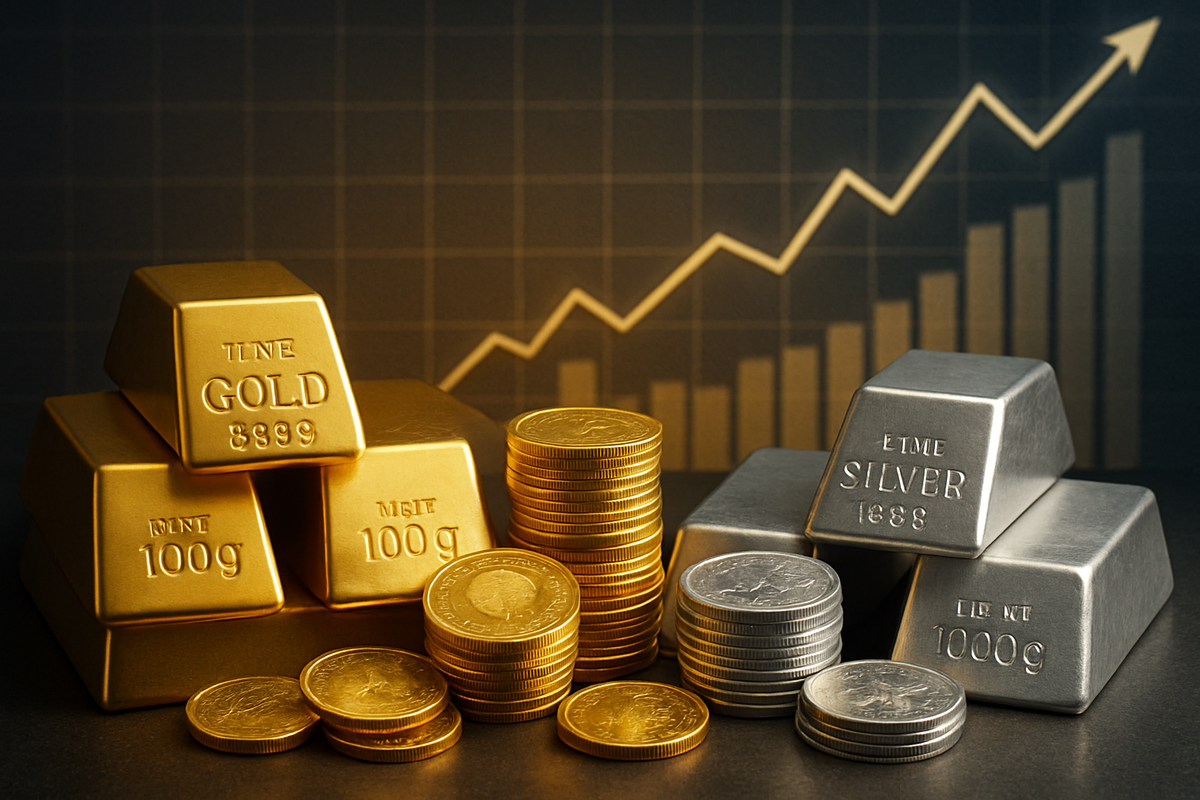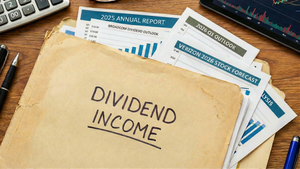
Gold and silver prices have recently experienced a remarkable surge, reaching unprecedented nominal highs in early to mid-October 2025. Gold eclipsed the $4,000 per ounce mark, even briefly touching nearly $4,398.00, while silver saw a significant spike, hitting $54 per ounce. This impressive rally has been fueled by a complex interplay of factors, including heightened safe-haven demand, expectations of aggressive monetary policy shifts, and a weakening U.S. dollar. While the initial climb was driven by these macro forces, subsequent sharp pullbacks from these peaks have prompted a wave of "bargain buying" from investors eager to capitalize on perceived dips, suggesting a nuanced market sentiment characterized by both caution and long-term bullish conviction.
The immediate implications of these price movements have been a period of significant market volatility. While the initial surge created substantial wealth for early investors, the corrections that followed, particularly around October 21-22, 2025, saw gold experience its largest single-day percentage decline in over a decade, with silver also enduring its steepest drop since 2021. This volatility underscores a market grappling with profit-taking pressures and a re-evaluation of risk, even as underlying demand for precious metals remains robust.
Unpacking the Precious Metals Phenomenon
The recent ascent of gold and silver to nominal record highs in early to mid-October 2025 was a culmination of several powerful market forces. Geopolitical tensions, including ongoing conflicts in Eastern Europe and the Middle East, coupled with domestic uncertainties like government shutdown threats and trade-tariff worries, significantly amplified safe-haven demand. Investors flocked to precious metals as a traditional hedge against global instability and economic uncertainty. Concurrently, aggressive expectations for interest rate cuts by the U.S. Federal Reserve reduced the opportunity cost of holding non-yielding assets like gold, making them more attractive. A weakening U.S. dollar further bolstered appeal for international buyers, as dollar-denominated commodities became more affordable.
Adding to the demand, central banks worldwide continued their robust accumulation of gold, a trend that has provided a strong foundational support for prices. For silver, beyond its safe-haven appeal, strong industrial demand from burgeoning sectors such as electronics, solar panel production, and electric vehicle manufacturing played a crucial role in its upward trajectory. The period around October 21-22, 2025, saw significant profit-taking after these record highs, leading to sharp, albeit temporary, corrections. These dips, however, were quickly met by strategic investors who viewed them as opportune moments for "bargain buying," reinforcing the long-term bullish sentiment.
Initial market reactions have been characterized by heightened volatility, with significant daily price swings. This has led to a degree of short-term caution among traders, but also a strategic re-evaluation of portfolios. The interplay between easing geopolitical tensions (e.g., optimism surrounding potential trade deals between the U.S., China, and India) and a firmer U.S. dollar has occasionally diverted funds towards riskier assets, yet the underlying drivers for precious metals persist. Market participants are now keenly awaiting crucial U.S. economic data, including the September Consumer Price Index (CPI) report (expected October 24) and the Federal Reserve's rate announcement (October 29), which are expected to significantly influence short-term price action and shape future interest rate expectations.
Winners and Losers in the Golden Rush
The strong gains in gold and silver prices create a highly favorable environment for public companies primarily engaged in precious metals mining, streaming, and royalty. These companies often offer leveraged exposure to metal prices, meaning their stock prices can appreciate at a greater rate than the metals themselves during a bull run.
Leading the charge are pure-play gold and silver miners with low All-in Sustaining Costs (AISC) and strong balance sheets. Companies like Pan American Silver Corp. (NASDAQ: PAAS), recognized for its robust balance sheet and significant reserves, and First Majestic Silver Corp. (NYSE: AG), considered one of the purest silver plays with over half its revenue from silver, are poised for substantial revenue and profit margin expansion. Other low-cost producers like Centerra Gold (TSX: CG) and Silvercorp Metals Inc. (TSX: SVM) (for silver) also stand to gain significantly as higher metal prices directly translate into improved profitability. These companies can leverage increased cash flow to reduce debt, fund exploration, and potentially increase shareholder returns through dividends or buybacks.
Precious metals streaming and royalty companies like Wheaton Precious Metals Corp. (NYSE: WPM) and Royal Gold Inc. (NASDAQ: RGLD) are particularly well-positioned. Their business model involves providing upfront capital to miners in exchange for the right to purchase future production at fixed, lower prices. This allows them to benefit directly and significantly from rising spot prices without incurring the operational risks and capital expenditures of mining. For instance, Wheaton Precious Metals has contractual rights to buy silver at an average price of $5.75 per ounce through 2029, making any price above that a direct profit.
Conversely, companies with high production costs, significant debt burdens, or unfavorable hedging strategies may benefit less or even struggle to fully capitalize on the rally. Highly diversified miners, such as BHP Group (NYSE: BHP) or Rio Tinto (ASX: RIO), which produce gold or silver as by-products, will see an uplift in their precious metals segments, but their overall performance remains more tied to their primary commodities like iron ore or copper. Exploration-stage companies without immediate production, while potentially attracting increased investor interest, do not realize direct revenue gains from higher spot prices until their projects become operational.
Investors seeking diversified exposure often turn to Exchange Traded Funds (ETFs). The VanEck Gold Miners ETF (NYSEARCA: GDX) and VanEck Junior Gold Miners ETF (NYSEARCA: GDXJ) provide exposure to large-cap and small-to-mid-cap gold and silver miners, respectively. Similarly, the Global X Silver Miners ETF (NYSEARCA: SIL) and Amplify Junior Silver Miners ETF (NYSEARCA: SILJ) track silver mining companies. These ETFs generally appreciate significantly during precious metals rallies, offering amplified profit potential, but also experience higher volatility during market pullbacks.
Broader Implications and Historical Context
The robust performance of gold and silver in October 2025 is not an isolated event but fits squarely within broader industry trends emphasizing safe-haven assets and inflation hedges. In an environment persistently challenged by inflation concerns, central bank balance sheet expansion, and geopolitical fragmentation, precious metals serve as a crucial diversifier and store of value. This event underscores a continued loss of confidence in traditional fiat currencies and government bonds as primary safe havens, particularly when real interest rates remain low or negative.
The ripple effects extend beyond the mining sector. Increased gold and silver prices can influence consumer spending on luxury goods, impacting jewelers and other retail segments. Industrially, higher silver prices could pressure manufacturers in electronics, solar, and EV sectors, potentially leading to innovation in material substitution or increased costs for consumers. Regulatory bodies and central banks will be closely monitoring these price movements, as sustained rallies could signal deeper economic anxieties or inflationary pressures that might necessitate policy adjustments. For example, if the Federal Reserve perceives precious metals' strength as a sign of uncontrolled inflation, it could influence their approach to interest rate decisions.
Historically, periods of significant geopolitical instability, high inflation, or economic uncertainty have almost always correlated with strong performance in gold and silver. The 1970s, marked by oil crises and high inflation, saw gold prices skyrocket. More recently, the post-2008 financial crisis era and periods of heightened trade tensions have witnessed similar flights to safety. The current rally shares characteristics with these historical precedents, reinforcing the metals' role as a counter-cyclical asset. However, the sheer scale of central bank buying and the unprecedented global debt levels add a unique dimension to the current cycle, suggesting that the underlying drivers may be more structural than cyclical.
The Road Ahead: Navigating the Precious Metals Landscape
Looking ahead, the precious metals market is poised for continued dynamism. In the short term, volatility is expected to persist, particularly as markets digest upcoming economic data like the September CPI report (due October 24) and the Federal Reserve's interest rate announcement (October 29). These events could trigger further price swings as investors recalibrate their expectations for monetary policy. However, many analysts view recent pullbacks as "healthy consolidation" within a broader long-term bullish trend, presenting strategic buying opportunities for long-term investors.
For mining companies, the sustained high prices present opportunities for strategic pivots. Enhanced cash flows can be directed towards aggressive exploration programs to expand reserves, debt reduction, or strategic mergers and acquisitions to consolidate market share and achieve economies of scale. Companies with strong project pipelines and efficient operations will be best positioned to capitalize. For investors, the market offers both opportunities and challenges. While the potential for further gains remains, the heightened volatility necessitates a cautious and well-researched approach, focusing on companies with solid fundamentals and disciplined management.
Potential scenarios include a sustained rally if inflation remains sticky and geopolitical tensions escalate, pushing gold towards even higher nominal records. Conversely, a rapid resolution of global conflicts or a more hawkish-than-expected stance from central banks could lead to further corrections. However, the fundamental demand drivers—central bank buying, industrial demand for silver, and the ongoing search for safe havens—are likely to provide a strong floor for prices in the long term. The market will be closely watching for any signs of a weakening U.S. dollar, which would further bolster precious metals' appeal, and the broader global economic narrative to gauge the next significant move.
A Comprehensive Wrap-Up: Gold and Silver's Enduring Appeal
The recent strong gains in gold and silver prices underscore their enduring appeal as critical components of a diversified investment portfolio, particularly in times of global uncertainty and inflationary pressures. The rally to nominal record highs, initially driven by safe-haven demand, monetary policy expectations, and central bank buying, highlights the metals' role as a hedge against systemic risk. While subsequent profit-taking introduced volatility and "bargain buying" opportunities, the underlying market sentiment remains broadly bullish for the long term.
Moving forward, the precious metals market is likely to remain dynamic. Investors should anticipate continued volatility in the short term, influenced by macroeconomic data and central bank pronouncements. However, the structural drivers supporting gold and silver—persistent inflation concerns, ongoing geopolitical instability, and robust industrial demand for silver—are expected to provide a strong foundation for future price appreciation. Mining companies with efficient operations and strong balance sheets are well-positioned to thrive, while streaming and royalty companies offer a unique, less operationally intensive way to capitalize on rising prices.
Investors should closely monitor global macroeconomic indicators, central bank policies, and geopolitical developments in the coming months. The performance of gold and silver will offer crucial insights into broader market confidence and inflationary expectations. While the allure of quick gains is strong, a strategic, long-term perspective, coupled with thorough due diligence on specific companies and ETFs, will be paramount for navigating this exciting yet volatile precious metals landscape.
This content is intended for informational purposes only and is not financial advice





